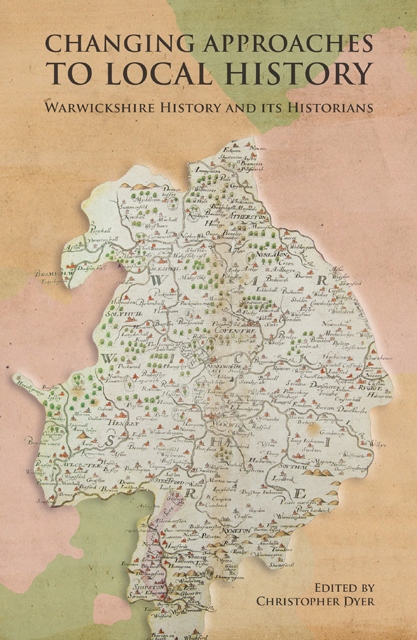Book contents
- Frontmatter
- Contents
- List of Illustrations
- Notes on Contributors
- Foreword
- Acknowledgements
- List of Abbreviations
- Introduction
- 1 The Dugdale Society: Its First Hundred Years
- 2 The Beginnings of Coventry
- 3 Was Commerce in Late Medieval Coventry Restricted by Regulation?
- 4 Studying Late Medieval Small Towns in Warwickshire 1920–2020
- 5 Rural Warwickshire in the Middle Ages: Society and Landscape
- 6 Religion, Rebellion and Red Jackets: Changing Approaches to Society and Politics in Sixteenth-century Warwickshire
- 7 Social Networks, Intellectual Affinities and Communal Harmony in Post-Reformation Warwickshire
- 8 Discovering Warwickshire’s Vernacular Architecture
- 9 Local History and the English Civil War: A View from Warwickshire
- 10 Writing Histories of the Landed Elite in Georgian Warwickshire
- 11 The Victoria County History in Warwickshire
- 12 Writing Women into the Political History of Warwickshire
- 13 Shakespeare and the Warwickshire Landscape in the Age of the Tourist
- Conclusion
- Index
9 - Local History and the English Civil War: A View from Warwickshire
Published online by Cambridge University Press: 17 December 2022
- Frontmatter
- Contents
- List of Illustrations
- Notes on Contributors
- Foreword
- Acknowledgements
- List of Abbreviations
- Introduction
- 1 The Dugdale Society: Its First Hundred Years
- 2 The Beginnings of Coventry
- 3 Was Commerce in Late Medieval Coventry Restricted by Regulation?
- 4 Studying Late Medieval Small Towns in Warwickshire 1920–2020
- 5 Rural Warwickshire in the Middle Ages: Society and Landscape
- 6 Religion, Rebellion and Red Jackets: Changing Approaches to Society and Politics in Sixteenth-century Warwickshire
- 7 Social Networks, Intellectual Affinities and Communal Harmony in Post-Reformation Warwickshire
- 8 Discovering Warwickshire’s Vernacular Architecture
- 9 Local History and the English Civil War: A View from Warwickshire
- 10 Writing Histories of the Landed Elite in Georgian Warwickshire
- 11 The Victoria County History in Warwickshire
- 12 Writing Women into the Political History of Warwickshire
- 13 Shakespeare and the Warwickshire Landscape in the Age of the Tourist
- Conclusion
- Index
Summary
This volume marks the centenary of the Dugdale Society, Warwickshire’s record society, named in honour of the herald and antiquarian Sir William Dugdale, whose publications included an exemplary county history, The Antiquities of Warwickshire (1656), and an account of the civil war, published late in his life, A Short View of the Late Troubles in England (1681). Both works were based on thorough research, the Warwickshire founded on extensive access to family papers as well as centrally held records, while A Short View benefited from Dugdale’s eye-witness testimony and documents collected while serving as an official in the royalist cause, along with contemporary pamphlets and sermon notes. Neither was straightforwardly ‘objective’, reminding us that all history has its inspirations, exclusions and points of view. The Warwickshire remains an important source for historians of the county gentry, and for important insights into how early modern gentlemen demonstrated and defended their status and their honour. But it can also be understood as a picture of an ‘imagined community’, creating as much as describing a ‘perceived affinity based on shared values’. Dugdale valued ‘ancient lineage’, and did not always acknowledge the impact of recent social mobility, and he mostly avoided discussion of the bitter political and religious divisions that had made Warwickshire a battleground a few years earlier. If no apparently descriptive local history is entirely innocent, Dugdale’s Short View was very different in tone, and underlines how controversial interpretations of the civil war have been, ever since the seventeenth century. This was ‘a polemical work written with a depth of feeling at odds with the scholarly image he sought to present to posterity’. Based on an even more intemperate earlier draft, it was published in 1681 during the Tory reaction after the ‘Exclusion crisis’ when ‘Whigs’ failed to keep the Catholic James, duke of York from the succession to the throne. Its clear aim was to demonstrate the dangers of resisting royal authority.
This chapter reflects on work done on Warwickshire and the civil war for a doctoral thesis and subsequently published in 1987. It was inspired by a general interest in the political history of early modern England, rather than by any local loyalties.
- Type
- Chapter
- Information
- Publisher: Boydell & BrewerPrint publication year: 2022

